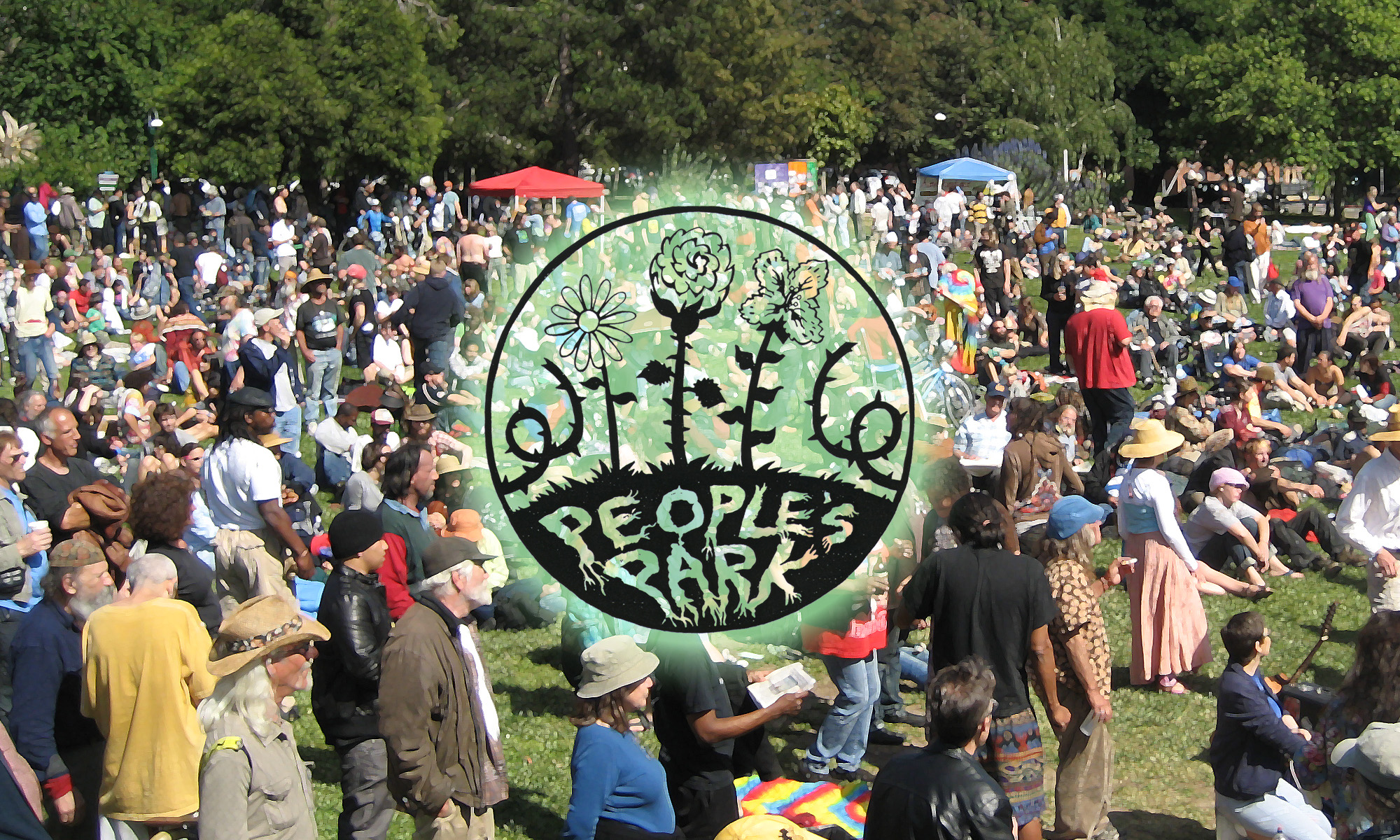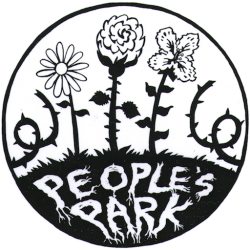More than 100 police officers, some from the UC Police and some from the California Highway Patrol conducted an armed take-over of the eastern portion of People’s Park early this morning, according to multiple witnesses. At least two adjacent streets were closed to vehicle and pedestrian traffic during the operation. At least three persons who were engaged in non-violent protest were arrested for sleeping at a vigil they have been keeping. (The police, however, report a total of six arrests). Police escorted a contracted (and likely non-union) tree cutting service into the park to kill and remove “several” large trees. Long time friend of the park, former counter-culture cartoonist and Berkeley resident Ace Backwords reports being moved to tears upon arriving to see the damage done.
The action comes on the heals of a prior early-morning “sneak attack” that removed trees on January 2, 2019. That action involved far fewer police but did help to grow the group of non-violent protesters from a small handful to around 50 this morning.
The University has asserted that the tree destruction is simply “deferred maintenance”. Park activists have pointed out that the University is destroying old, healthy, beautiful trees that posed no risk to public health and safety. Further, as reported in the Daily Planet, the University appears to be acting in violation of a memorandum of understanding established in 1979 governing the fate of trees in the Park (“Trees Have Standing; the Day a Tree Visited the Chancellor”, Carol Denny, Berkeley Daily Planet January 11, 2019)
The action comes in the context of allegations that the University poorly maintained a Eucalyptus tree outside the park. That tree fell north of the Greek Theater on the University of California Berkeley campus, killing Alexander Grant of Novato on January 7, 2019. The University has come under scrutiny due to allegations the proximate cause of Euc’s fall was the result of damage negligently caused by the University itself. (“The Death Tree at UC Berkeley: Why Did It Happen?”, Hank Chapot, Berkeley Daily Planet January 11, 2019.)
On Berkeleyside, Dan Mogulof, Office of Communications and Public Affairs at UC Berkeley, recently asserted that tree cutting in the Park is unrelated to University plans to destroy the park and and lease the land to a for-profit developer (Berkeleyside comment by Dan Mogulof on the “Opinion: UC Berkeley was devious when it had crews cut down 12 trees at People’s Park”, by Tom Dazell, January 2, 2019). Defenders of the park widely believe otherwise, regarding the tree-cutting as preparation for destroying the park, and as a test of the size of the resistance that will defend the park. Ironically, the University’s actions have helped to attract new defenders to the Save the Park movement.
Ultimately, the University would like to lease the Park to a third party developer that specializes in operating for-profit dormitories. Construction was completed of a similar project recently (Blackwell Hall at 2401 Durant Ave.). The so-called public-private partnerships spare the administration of fully financing construction but at the steep cost of charging dorm residents high rents, forever, to guarantee that a substantial profit can be made from student fees and financial aid. Students at Cal face rent gouging almost every which way they turn in Berkeley and now the University is giving privately owned, for-profit corporations a taste of that action – handing over public land to them in the process. This is some grade-A prime bullshit whether you are a student being ripped off or a California resident watching the public commons and open space be trashed on behalf of private gain.
The University is steadfast, though, in its intention to destroy the Park, a thorn in its side ever since Ronald Reagan unleashed a murderous police riot in Berkeley in a failed attempt to prevent the Park from being created by the community in the first place. The rioting police murdered James Rector with buckshot and blinded carpenter Alan Blanchard with birdshot. Verbal histories and contemporary on-air, on-the-scene reporting by KPFA report that numerous other people were also taken to the hospital after being shot by the police that day. The riot culminated in a declaration of marshal law and an occupation of Berkeley by the national guard, including mass casualty gassing of parts of the City from helicopter, persistent barricades and checkpoints, curfews, and the shock-and-awe menacing of the public with rifles and bayonets. The Guard made hundreds of arrests and arrestees report being tortured by guards at Santa Rita county jail.
The people ultimately prevailed and by 1972 the Park was established. The people, though outgunned (literally many thousands of guns against 0 guns), won by attrition — reacting to police riots with property destruction (particularly police cars), tearing down fences, and holding the moral high ground given them by Reagan’s over-reach.
Today’s organized resistance to Save the Park is, so far, small but growing. The activists are committed to non-violence. Provocations like the tree cutting damage the Park greatly, but they are also helping to attract new Park defenders. The University’s devious tactics, underhanded approach in breaking long-standing agreements, and nakedly excessive shows of force are hard to understand unless perhaps the University hopes to incite renewed violence between the police and the people.
The Park is much loved by many potential defenders not only for its beauty, utility, and history of hosting cultural events — but also because it has served for decades as a site of respite and social services for the poor. Since its founding, the Park has served as a daytime People’s community space, often serving homeless people and those struggling in various ways. The Park is the site of community provided meals, peer counseling on substance abuse issues, safety, and company. At one time the Park was host to a system of redistribution known as “the Free Box” (take what you need, leave what you don’t) though the University succeeded in destroying that some years ago. (At the time, a University spokesperson expressed that it was not best way to get clothes to poor people but she offered no alternative. She was also scandalized by the thought that a poor person might sell something from the free box to a used clothing boutique and use the money for other things — perhaps even beer.) The University has vaguely suggested it will remediate the loss of people-powered social services by providing conventional social services but no such bureaucratic institution has every managed to do with millions of dollars what is regularly accomplished more directly by the people.
As of this writing, Mayor Jesse Arreguín has released no statement about this latest provocation by the University. Activists expect that the Mayor strongly favors the tree cutting and para-military intimidation tactics. Arreguín has previously enthused over plans to raze the park, in spite of supporting the park wile he was campaigning. He has additionally encouraged the University to enter into partnership with private developers to build for-profit, high-rent dorms. He is known for delaying efforts to strengthen citizen oversight of the police, and for supporting the participation of the Police in the racist and militarized training and trade show known as Urban Shield. He has declared that anti-fascist protesters are in effect a criminal gang. He has led the City so spend millions on a net reduction of available shelter beds. He has ushered in new, harsh legislation meant to drive homeless people from the heart of downtown by means of police action.
— Thomas Lord, January 15, 2019, 11:49 am
I think the facts are in order but if it needs correction, the sooner the better please.

